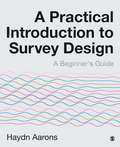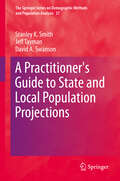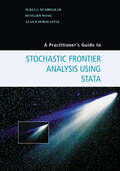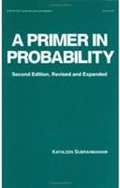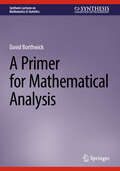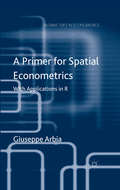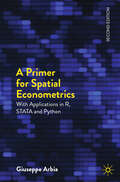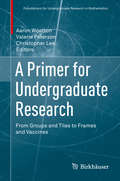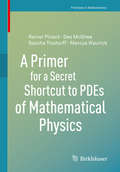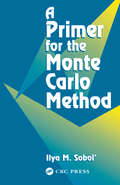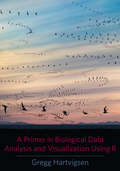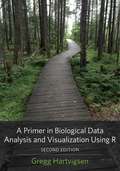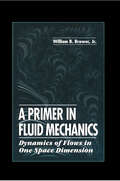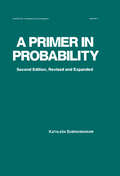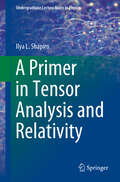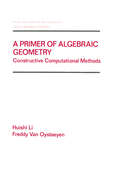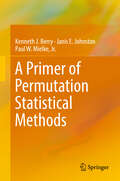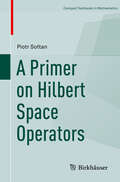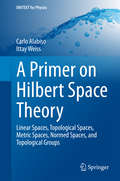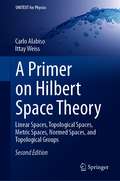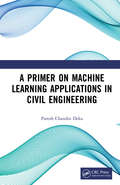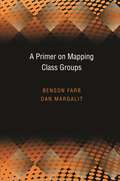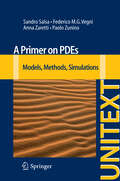- Table View
- List View
A Practical Introduction to Survey Design: A Beginner′s Guide
by Haydn AaronsThis is your definitive guide to designing your social survey. It includes all the knowledge and skills you need to plan your survey with confidence and ease. Every step of survey design from developing your questions, to administering your survey and preparing your data for analysis, is explained in easy to follow language. It features: Case studies demonstrating how effective surveys are conducted in real life Clear advice on how to design an ethical social survey Practical exercises to help you construct your survey Suggestions for further reading taken from cutting edge, multidisciplinary sources The book also comes with a host of useful online resources, including templates and reflective questions, to help strengthen your understanding and apply your new found knowledge.
A Practitioner's Guide to State and Local Population Projections (The Springer Series on Demographic Methods and Population Analysis #37)
by David A. Swanson Stanley K. Smith Jeff TaymanThis book focuses on the methodology and analysis of state and local population projections. It describes the most commonly used data sources and application techniques for four types of projection methods: cohort-component, trend extrapolation, structural models, and microsimulation. It covers the components of population growth, sources of data, the formation of assumptions, the development of evaluation criteria, and the determinants of forecast accuracy. It considers the strengths and weaknesses of various projection methods and pays special attention to the unique problems that characterize small-area projections. The authors provide practical guidance to demographers, planners, market analysts, and others called on to construct state and local population projections. They use many examples and illustrations and present suggestions for dealing with special populations, unique circumstances, and inadequate or unreliable data. They describe techniques for controlling one set of projections to another, for interpolating between time points, for sub-dividing age groups, and for constructing projections of population-related variables (e. g. , school enrollment, households). They discuss the role of judgment and the importance of the political context in which projections are made. They emphasize the "utility" of projections, or their usefulness for decision making in a world of competing demands and limited resources. This comprehensive book will provide readers with an understanding not only of the mechanics of the most commonly used population projection methods, but also of the many complex issues affecting their construction, interpretation, evaluation, and use.
A Practitioner's Guide to Stochastic Frontier Analysis Using Stata
by Subal C. Kumbhakar Hung-Jen Wang Alan P. HorncastleStochastic Frontier Analysis Using Stata provides practitioners in academia and industry with a step-by-step guide on how to conduct efficiency analysis using the stochastic frontier approach. The authors explain in detail how to estimate production, cost, and profit efficiency and introduce the basic theory of each model in an accessible way, using empirical examples that demonstrate the interpretation and application of models. This book also provides computer code, allowing users to apply the models in their own work, and incorporates the most recent stochastic frontier models developed in academic literature. Such recent developments include models of heteroscedasticity and exogenous determinants of inefficiency, scaling models, panel models with time-varying inefficiency, growth models, and panel models that separate firm effects and persistent and transient inefficiency. Immensely helpful to applied researchers, this book bridges the chasm between theory and practice, expanding the range of applications in which production frontier analysis may be implemented.
A Primer In Probability (Statistics: A Series Of Textbooks And Monographs #Vol. 111)
by Kathleen SubrahmaniamSomewhat revised/expanded new edition of a problem-oriented introductory undergraduate text, the first edition of which appeared about a decade ago. The author writes with courteous clarity, and imposes only modest demands upon the mathematical skills of her readers.
A Primer On String Theory
by Volker SchomerusSince its conception in the 1960s, string theory has been hailed as one of the most promising routes we have to unify quantum mechanics and general relativity. This book provides a concise introduction to string theory explaining central concepts, mathematical tools and covering recent developments in physics including compactifications and gauge/string dualities. With string theory being a multidisciplinary field interfacing with high energy physics, mathematics and quantum field theory, this book is ideal for both students with no previous knowledge of the field and scholars from other disciplines who are looking for an introduction to basic concepts.
A Primer for Mathematical Analysis (Synthesis Lectures on Mathematics & Statistics)
by David BorthwickThis book presents a concise introduction to real and complex number systems and metric space theory. The goal is to help students bridge the gap between undergraduate courses in advanced calculus and graduate level material in analysis or related subjects such as differential geometry or probability. The unifying feature in all of these subject areas is the predominance of the limit, and metric space theory is the mathematical language in which limits are formulated. To understand analysis at a graduate level, students need to develop fluency in this language. To facilitate this development, exercises are incorporated into the main text, with many key results posed as problems. Solutions are provided to help readers fill in any gaps.
A Primer for Spatial Econometrics: With Applications In R (Palgrave Texts in Econometrics)
by Giuseppe ArbiaThis book aims at meeting the growing demand in the field by introducing the basic spatial econometrics methodologies to a wide variety of researchers. It provides a practical guide that illustrates the potential of spatial econometric modelling, discusses problems and solutions and interprets empirical results.
A Primer for Spatial Econometrics: With Applications in R, STATA and Python (Palgrave Texts in Econometrics)
by Giuseppe ArbiaThis textbook offers a practical and engaging introduction to spatial econometric modelling, detailing the key models, methodologies and tools required to successfully apply a spatial approach. The second edition contains new methodological developments, new references and new software routines in R that have emerged since the first edition published in 2014. It also extends practical applications with the use of the software STATA and of the programming language Python. The first software is used increasingly by many economists, applied econometricians and social scientists while the software Python is becoming the elective choice in many scientific applications. With new statistical appendices in R, STATA and Python, as well as worked examples, learning questions, exercises and technical definitions, this is a significantly expanded second edition that will be a valuable resource for advanced students of econometrics.
A Primer for Undergraduate Research: From Groups and Tiles to Frames and Vaccines (Foundations for Undergraduate Research in Mathematics)
by Christopher Lee Aaron Wootton Valerie PetersonThis highly readable book aims to ease the many challenges of starting undergraduate research. It accomplishes this by presenting a diverse series of self-contained, accessible articles which include specific open problems and prepare the reader to tackle them with ample background material and references. Each article also contains a carefully selected bibliography for further reading.The content spans the breadth of mathematics, including many topics that are not normally addressed by the undergraduate curriculum (such as matroid theory, mathematical biology, and operations research), yet have few enough prerequisites that the interested student can start exploring them under the guidance of a faculty member. Whether trying to start an undergraduate thesis, embarking on a summer REU, or preparing for graduate school, this book is appropriate for a variety of students and the faculty who guide them.
A Primer for a Secret Shortcut to PDEs of Mathematical Physics (Frontiers in Mathematics)
by Marcus Waurick Des McGhee Rainer Picard Sascha TrostorffThis book presents a concise introduction to a unified Hilbert space approach to the mathematical modelling of physical phenomena which has been developed over recent years by Picard and his co-workers. The main focus is on time-dependent partial differential equations with a particular structure in the Hilbert space setting that ensures well-posedness and causality, two essential properties of any reasonable model in mathematical physics or engineering.However, the application of the theory to other types of equations is also demonstrated. By means of illustrative examples, from the straightforward to the more complex, the authors show that many of the classical models in mathematical physics as well as more recent models of novel materials and interactions are covered, or can be restructured to be covered, by this unified Hilbert space approach.The reader should require only a basic foundation in the theory of Hilbert spaces and operators therein. For convenience, however, some of the more technical background requirements are covered in detail in two appendices The theory is kept as elementary as possible, making the material suitable for a senior undergraduate or master’s level course. In addition, researchers in a variety of fields whose work involves partial differential equations and applied operator theory will also greatly benefit from this approach to structuring their mathematical models in order that the general theory can be applied to ensure the essential properties of well-posedness and causality.
A Primer for the Monte Carlo Method
by Ilya M. SobolThe Monte Carlo method is a numerical method of solving mathematical problems through random sampling. As a universal numerical technique, the method became possible only with the advent of computers, and its application continues to expand with each new computer generation. A Primer for the Monte Carlo Method demonstrates how practical problems in science, industry, and trade can be solved using this method. The book features the main schemes of the Monte Carlo method and presents various examples of its application, including queueing, quality and reliability estimations, neutron transport, astrophysics, and numerical analysis. The only prerequisite to using the book is an understanding of elementary calculus.
A Primer in Biological Data Analysis and Visualization Using R
by Gregg HartvigsenR is the most widely used open-source statistical and programming environment for the analysis and visualization of biological data. Drawing on Gregg Hartvigsen's extensive experience teaching biostatistics and modeling biological systems, this text is an engaging, practical, and lab-oriented introduction to R for students in the life sciences.Underscoring the importance of R and RStudio in organizing, computing, and visualizing biological statistics and data, Hartvigsen guides readers through the processes of entering data into R, working with data in R, and using R to visualize data using histograms, boxplots, barplots, scatterplots, and other common graph types. He covers testing data for normality, defining and identifying outliers, and working with non-normal data. Students are introduced to common one- and two-sample tests as well as one- and two-way analysis of variance (ANOVA), correlation, and linear and nonlinear regression analyses. This volume also includes a section on advanced procedures and a chapter introducing algorithms and the art of programming using R.
A Primer in Biological Data Analysis and Visualization Using R
by Gregg HartvigsenR is the most widely used open-source statistical and programming environment for the analysis and visualization of biological data. Drawing on Gregg Hartvigsen’s extensive experience teaching biostatistics and modeling biological systems, this text is an engaging, practical, and lab-oriented introduction to R for students in the life sciences.Underscoring the importance of R and RStudio in organizing, computing, and visualizing biological statistics and data, Hartvigsen guides readers through the processes of correctly entering and analyzing data and using R to visualize data using histograms, boxplots, barplots, scatterplots, and other common graph types. He covers testing data for normality, defining and identifying outliers, and working with non-normally distributed data. Students are introduced to common one- and two-sample tests as well as one- and two-way analysis of variance (ANOVA), correlation, and linear and nonlinear regression analyses. This volume also includes a section on advanced procedures and a chapter outlining algorithms and the art of programming using R.This second edition has been revised to be current with the versions of R software released since the book’s original publication. It features updated terminology, sources, and examples throughout.
A Primer in Fluid MechanicsDynamics of Flows in One Space Dimension
by Jr. BrowerThis distinctive text presents the basic principles of fluid mechanics by means of one-dimensional flow examples - differing significantly in style and content from other books. A Primer in Fluid Mechanics contains:an overview of fluid properties and the kinetic theory of gases information on the fundamental equations of fluid mechanics, including historical references and background information introductory discussions on fluid properties and fluid statics a comprehensive chapter on compressible flow a variety of applications on non-steady flow, including non-steady gas dynamics a brief introduction to acousticsNovel provisos in the text include an analysis of the static stability of a floating two-dimensional parabolic section viscous flow through an elastic duct several geometries in non-steady tank draining, including a singular perturbation problemChapters also discuss physical properties, atmospheric stability, thermodynamics, energy and momentum equations, dimensional analysis, and historical perspectives of flows in pipes and conduits.A Primer in Fluid Mechanics offers a rigorous text for the curious student and for the research engineer seeking a readily available guide to the more refined treatments in the literature - supporting classical and current discussions as well as theoretical and practical concepts.
A Primer in Probability (Statistics: A Series of Textbooks and Monographs)
by Kathleen SubrahmaniamSomewhat revised/expanded new edition of a problem-oriented introductory undergraduate text, the first edition of which appeared about a decade ago. The author writes with courteous clarity, and imposes only modest demands upon the mathematical skills of her readers. Problems at the end of each of t
A Primer in Tensor Analysis and Relativity (Undergraduate Lecture Notes in Physics)
by Ilya L. ShapiroThis undergraduate textbook provides a simple, concise introduction to tensor algebra and analysis, as well as special and general relativity. With a plethora of examples, explanations, and exercises, it forms a well-rounded didactic text that will be useful for any related course.The book is divided into three main parts, all based on lecture notes that have been refined for classroom teaching over the past two decades. Part I provides students with a comprehensive overview of tensors. Part II links the very introductory first part and the relatively advanced third part, demonstrating the important intermediate-level applications of tensor analysis. Part III contains an extended discussion of general relativity, and includes material useful for students interested primarily in quantum field theory and quantum gravity.Tailored to the undergraduate, this textbook offers explanations of technical material not easily found or detailed elsewhere, including an understandable description of Riemann normal coordinates and conformal transformations. Future theoretical and experimental physicists, as well as mathematicians, will thus find it a wonderful first read on the subject.
A Primer of Algebraic Geometry: Constructive Computational Methods (Pure and Applied Mathematics #227)
by Huishi Li Freddy Van OystaeyenPresents the structure of algebras appearing in representation theory of groups and algebras with general ring theoretic methods related to representation theory. Covers affine algebraic sets and the nullstellensatz, polynomial and rational functions, projective algebraic sets. Groebner basis, dimension of algebraic sets, local theory, curves and elliptic curves, and more.
A Primer of Permutation Statistical Methods
by Kenneth J. Berry Janis E. Johnston Paul W. Mielke, Jr.The primary purpose of this textbook is to introduce the reader to a wide variety of elementary permutation statistical methods. Permutation methods are optimal for small data sets and non-random samples, and are free of distributional assumptions. The book follows the conventional structure of most introductory books on statistical methods, and features chapters on central tendency and variability, one-sample tests, two-sample tests, matched-pairs tests, one-way fully-randomized analysis of variance, one-way randomized-blocks analysis of variance, simple regression and correlation, and the analysis of contingency tables. In addition, it introduces and describes a comparatively new permutation-based, chance-corrected measure of effect size. Because permutation tests and measures are distribution-free, do not assume normality, and do not rely on squared deviations among sample values, they are currently being applied in a wide variety of disciplines. This book presents permutation alternatives to existing classical statistics, and is intended as a textbook for undergraduate statistics courses or graduate courses in the natural, social, and physical sciences, while assuming only an elementary grasp of statistics.
A Primer on Hilbert Space Operators (Compact Textbooks in Mathematics)
by Piotr SołtanThe book concisely presents the fundamental aspects of the theory of operators on Hilbert spaces. The topics covered include functional calculus and spectral theorems, compact operators, trace class and Hilbert-Schmidt operators, self-adjoint extensions of symmetric operators, and one-parameter groups of operators. The exposition of the material on unbounded operators is based on a novel tool, called the z-transform, which provides a way to encode full information about unbounded operators in bounded ones, hence making many technical aspects of the theory less involved.
A Primer on Hilbert Space Theory: Linear Spaces, Topological Spaces, Metric Spaces, Normed Spaces, and Topological Groups (UNITEXT for Physics)
by Carlo Alabiso Ittay WeissThis book is an introduction to the theory of Hilbert space, a fundamental tool for non-relativistic quantum mechanics. Linear, topological, metric, and normed spaces are all addressed in detail, in a rigorous but reader-friendly fashion. The rationale for an introduction to the theory of Hilbert space, rather than a detailed study of Hilbert space theory itself, resides in the very high mathematical difficulty of even the simplest physical case. Within an ordinary graduate course in physics there is insufficient time to cover the theory of Hilbert spaces and operators, as well as distribution theory, with sufficient mathematical rigor. Compromises must be found between full rigor and practical use of the instruments. The book is based on the author's lessons on functional analysis for graduate students in physics. It will equip the reader to approach Hilbert space and, subsequently, rigged Hilbert space, with a more practical attitude. With respect to the original lectures, the mathematical flavor in all subjects has been enriched. Moreover, a brief introduction to topological groups has been added in addition to exercises and solved problems throughout the text. With these improvements, the book can be used in upper undergraduate and lower graduate courses, both in Physics and in Mathematics.
A Primer on Hilbert Space Theory: Linear Spaces, Topological Spaces, Metric Spaces, Normed Spaces, and Topological Groups (UNITEXT for Physics)
by Carlo Alabiso Ittay WeissThis book offers an essential introduction to the theory of Hilbert space, a fundamental tool for non-relativistic quantum mechanics. Linear, topological, metric, and normed spaces are all addressed in detail, in a rigorous but reader-friendly fashion. The rationale for providing an introduction to the theory of Hilbert space, rather than a detailed study of Hilbert space theory itself, lies in the strenuous mathematics demands that even the simplest physical cases entail. Graduate courses in physics rarely offer enough time to cover the theory of Hilbert space and operators, as well as distribution theory, with sufficient mathematical rigor. Accordingly, compromises must be found between full rigor and the practical use of the instruments. Based on one of the authors’s lectures on functional analysis for graduate students in physics, the book will equip readers to approach Hilbert space and, subsequently, rigged Hilbert space, with a more practical attitude. It also includes a brief introduction to topological groups, and to other mathematical structures akin to Hilbert space. Exercises and solved problems accompany the main text, offering readers opportunities to deepen their understanding. The topics and their presentation have been chosen with the goal of quickly, yet rigorously and effectively, preparing readers for the intricacies of Hilbert space. Consequently, some topics, e.g., the Lebesgue integral, are treated in a somewhat unorthodox manner. The book is ideally suited for use in upper undergraduate and lower graduate courses, both in Physics and in Mathematics.
A Primer on Linear Models (Chapman & Hall/CRC Texts in Statistical Science)
by John F. MonahanA Primer on Linear Models presents a unified, thorough, and rigorous development of the theory behind the statistical methodology of regression and analysis of variance (ANOVA). It seamlessly incorporates these concepts using non-full-rank design matrices and emphasizes the exact, finite sample theory supporting common statistical methods.
A Primer on Machine Learning Applications in Civil Engineering
by Paresh Chandra DekaMachine learning has undergone rapid growth in diversification and practicality, and the repertoire of techniques has evolved and expanded. The aim of this book is to provide a broad overview of the available machine-learning techniques that can be utilized for solving civil engineering problems. The fundamentals of both theoretical and practical aspects are discussed in the domains of water resources/hydrological modeling, geotechnical engineering, construction engineering and management, and coastal/marine engineering. Complex civil engineering problems such as drought forecasting, river flow forecasting, modeling evaporation, estimation of dew point temperature, modeling compressive strength of concrete, ground water level forecasting, and significant wave height forecasting are also included. Features Exclusive information on machine learning and data analytics applications with respect to civil engineering Includes many machine learning techniques in numerous civil engineering disciplines Provides ideas on how and where to apply machine learning techniques for problem solving Covers water resources and hydrological modeling, geotechnical engineering, construction engineering and management, coastal and marine engineering, and geographical information systems Includes MATLAB® exercises
A Primer on Mapping Class Groups (Princeton Mathematical Series #41)
by Benson Farb Dan MargalitThe study of the mapping class group Mod(S) is a classical topic that is experiencing a renaissance. It lies at the juncture of geometry, topology, and group theory. This book explains as many important theorems, examples, and techniques as possible, quickly and directly, while at the same time giving full details and keeping the text nearly self-contained. The book is suitable for graduate students. A Primer on Mapping Class Groups begins by explaining the main group-theoretical properties of Mod(S), from finite generation by Dehn twists and low-dimensional homology to the Dehn-Nielsen-Baer theorem. Along the way, central objects and tools are introduced, such as the Birman exact sequence, the complex of curves, the braid group, the symplectic representation, and the Torelli group. The book then introduces Teichmüller space and its geometry, and uses the action of Mod(S) on it to prove the Nielsen-Thurston classification of surface homeomorphisms. Topics include the topology of the moduli space of Riemann surfaces, the connection with surface bundles, pseudo-Anosov theory, and Thurston's approach to the classification.
A Primer on PDEs: Models, Methods, Simulations (UNITEXT)
by Anna Zaretti Federico Vegni Paolo Zunino Sandro SalsaThis book is designed as an advanced undergraduate or a first-year graduate course for students from various disciplines like applied mathematics, physics, engineering. It has evolved while teaching courses on partial differential equations during the last decade at the Politecnico of Milan. The main purpose of these courses was twofold: on the one hand, to train the students to appreciate the interplay between theory and modelling in problems arising in the applied sciences and on the other hand to give them a solid background for numerical methods, such as finite differences and finite elements.
